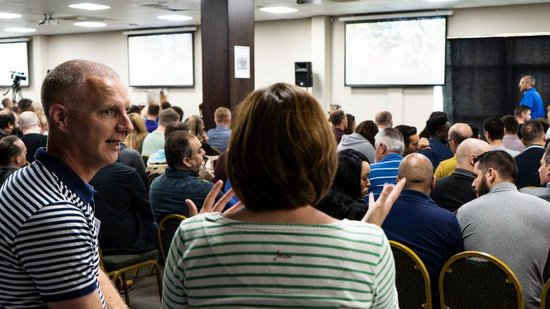Once you have found the perfect venue, now is the time to outline the layout and seating plan. Whether you’re organising a business meeting or conference, the seating arrangements have a massive impact on how the conversations flow throughout the event. The meeting seating plan you choose for your event has the potential to transform a silent room into a vibrant networking venue.
How do you choose a meeting seating plan for your event? The right choice depends on what the goals of your event are, the number of people attending, and what activities are on the agenda. If you want the sounds of insightful discussions and laughter to ring around your venue, your seating must be laid out to encourage conversation.
To help you arrange your meeting seating plan to do this, we have compiled some of the most popular seating layouts being used in 2022. Keep reading to explore how to lay out a seating plan to encourage conversation.
What Are The Main Types Of Meeting Seating Plans?
Auditorium
A theatre-style seating plan, an auditorium layout is a simple way to accommodate many guests comfortably. The layout uses built-in seats or rows of chairs that all face forward towards the focus of the event, typically a stage or podium. If you want your event to encourage conversations, this type of seating isn’t effective as it’s suited for a lecture or presentation.
Pros:
- Seat a large number of guests comfortably.
- Ideal for presentations, lectures, or ceremonies.
Cons:
- Doesn’t encourage audience participation or conversation.
- May require AV equipment so all attendees can see and hear the presentator.
Chevron
Chevron seating features several rows of chairs arranged on an angle to face towards a single point of focus. There is typically an aisle way towards the middle of the seating plan. Organisers can also incorporate tables at the front of the chairs to encourage collaboration while directing attention to a speaker.
Pros:
- Conversation is encouraged and possible in small groups.
- Maximises the available space.
Cons:
- Doesn’t support large group discussions.
- Seats need to be staggered to ensure all attendees can view the point of focus clearly.
Banquet
A banquet meeting seating plan uses round tables spread out throughout a room with chairs sitting around them. Each table should typically seat 8-10 people, however, this depends on the size of furniture available.
Pros:
- Ideal for encouraging conversations, networking, and socialising.
- Comfortable and spread-out seating.
Cons:
- It’s difficult for attendees to interact with guests sitting at other tables.
- Need a large amount of available space.
Cabaret
Similar to a banquet-style layout, cabaret seating uses circular tables throughout a room with chairs placed around them; however, there are two crucial differences. The first difference is that the tables are smaller so have fewer chairs around them. Secondly, the chairs don’t circle the entirety of the table, leaving a gap that points towards a stage or podium.
Pros:
- Conversations are encouraged while presentations are still visible for all attendees.
- A relaxed way for guests to view a performance or speech.
Cons:
Requires lots of space.
Boardroom
Boardroom seating plans encourage conversations and make any discussions simple to chair. The layout features one long rectangular table with chairs placed along both sides of the table. Attendees all face one another, however, the person leading any discussions should be seated at the head of the table.
Pros:
- Enables strategic placement of attendees along the table.
- Encourages collaborative discussions that are easy to manage.
Cons:
Can be difficult for all guests to be heard during discussions.
U-Shaped
Also known as horseshoe seating, u-shaped seating plans place tables in the shape of the letter ‘u’ facing a stage or podium. All attendees can turn to face one another during discussions or face towards the point of focus during a presentation.
Pros:
- Ideal for brainstorming sessions and group collaborations.
- Enables audience interaction with speakers.
Cons:
- Not suitable for events with a large number of guests.
- Requires a facilitator to manage any discussions.
Hollow Square
A hollow square seating plan uses rectangular tables arranged to create a square. The empty space in the middle of the tables is where the hollow square name comes from. All guests can see each other at the same time, which encourages group discussions while providing space for note-taking, food, or laptops.
Pros:
- Encourages organic discussions.
- Collaboration is easy as all attendees can view one another at once.
Cons:
- No clear point of focus.
- Doesn’t maximise available floor space.
Classroom
Classrooms are for learning. If you’re organising an event where guests want to leave knowing something new, this is the ideal seating plan. Classroom meeting seating plans use short rows of tables and chairs pointed towards a screen and space where a presenter can stand.
Pros:
- Note-taking is simple, either using a notebook or laptop.
- Focuses the attention of all guests.
Cons:
- Requires suitable floor space to avoid attendees feeling crowded.
- May feel cliche if the focus isn’t on the right topic.
Cocktail
Push the chairs and tables to the edge of the room and leave guests free to mingle and network. Add small circular tables without chairs for attendees to rest their glasses or plates if you’re serving food.
Pros:
- Encourages networking between attendees.
- Gives guests the freedom to initiate their own conversations.
Cons:
- Reduces the amount of seating.
- Requires a large amount of available space.
How To Layout a Seating Plan For Conversation?
There are many types of meeting seating plans to choose from if you want to spark conversations between guests. The right choice for your event depends on what your goals are, who is attending, and your available space. However, when organising a seating plan to encourage collaboration and conversation among attendees follow these three tips.
- Ensure all guests can face each other.
- Place attendees close together while keeping them comfortable.
- Encourage audience participation by placing guests close to the speaker if you’re organising a presentation.
cinch Stadium at Franklin’s Gardens
Are you looking to spark creativity and conversations around your event? Explore Franklin’s Gardens’ available conference venues and meeting rooms today to unlock the potential of your meeting seating plan. As well as unique event venues, Franklin’s Gardens offers high-quality specialist AV equipment that can transform any event.
Get in touch with our events team today, call us on 01604 751543 or visit our contact page to enquire further.






